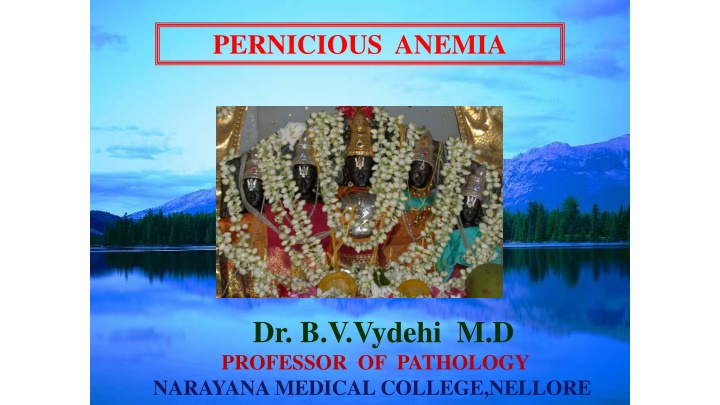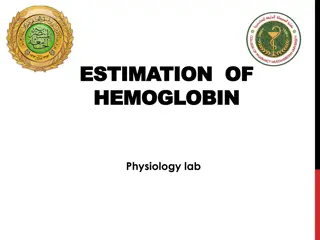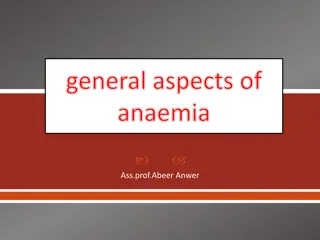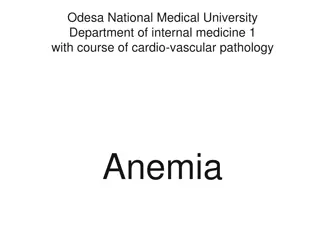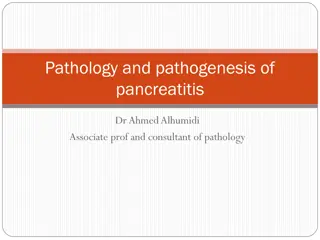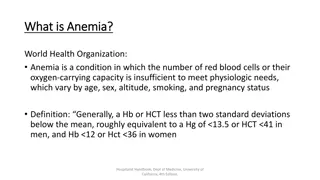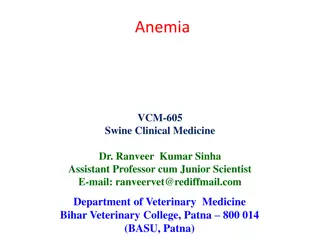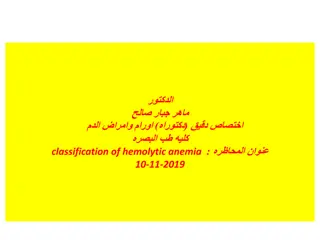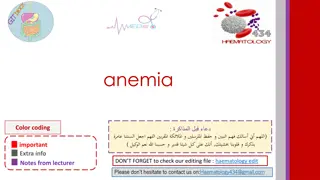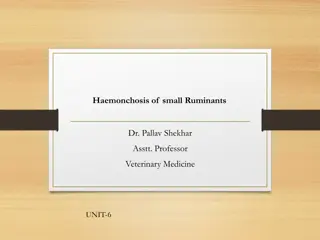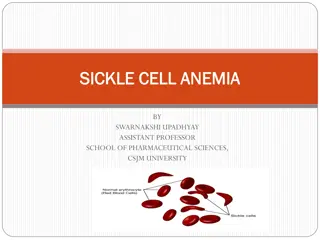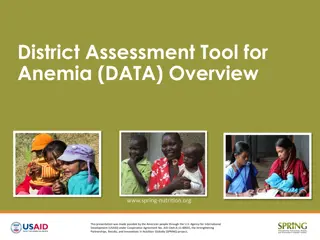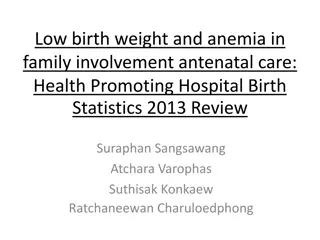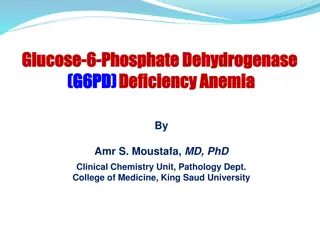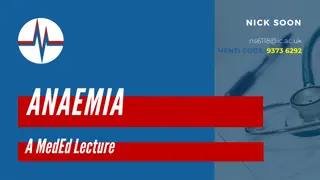Pernicious Anemia: Clinical Features and Pathogenesis
Pernicious Anemia, a chronic autoimmune disorder, is characterized by IF deficiency due to gastric mucosa atrophy. Learn about its pathogenesis, associated diseases, clinical features like anemia-related symptoms, skin changes, GI issues, and nervous system manifestations. Explore specific biochemical tests for folate deficiency.
Download Presentation

Please find below an Image/Link to download the presentation.
The content on the website is provided AS IS for your information and personal use only. It may not be sold, licensed, or shared on other websites without obtaining consent from the author.If you encounter any issues during the download, it is possible that the publisher has removed the file from their server.
You are allowed to download the files provided on this website for personal or commercial use, subject to the condition that they are used lawfully. All files are the property of their respective owners.
The content on the website is provided AS IS for your information and personal use only. It may not be sold, licensed, or shared on other websites without obtaining consent from the author.
E N D
Presentation Transcript
PERNICIOUS ANEMIA Dr. B.V.Vydehi M.D PROFESSOR OF PATHOLOGY NARAYANA MEDICAL COLLEGE,NELLORE
Pernicious Anemia Chronic autoimmune disorder of middle-aged & elderly of either sex in which IF deficiency occurs due to atrophy of gastric mucosa First described by Addison Addisonian megaloblastic anemia
Pernicious Anemia-Pathogenesis Possibly autoimmune destruction of gastric mucosa chronic atrophic gastritis 3 types of antibodies are present in PA (i) Type I (Anti IF antibodies) :Most specific - Found in both plasma & gastric juice (ii) Type II antibodies : Seen in majority - prevent binding of IF -Vit. B12 complex to its ileal receptor (iii) Type III antibodies (Anti-Parietal cell ab): - 90 % of cases - Not specific, as also seen in idiopathic chronic gastritis
Pernicious Anemia-Pathogenesis Associated with other auto-immune diseases such as autoimmune Thyroiditis, Adrenalitis, Diabetes etc., PA is more common in agammaglobulinemia supporting the role of cellular immune system
Pernicious Anemia Pernicious Anemia- -Clinical features Clinical features 1.. Symptoms related to anemia 2. Skin:Hyperpigmentation esp.of palms of hands, vitiligo, premature graying of hair 3.G.I.T : Nausea, vomting, heartburn, constipation or diarrhoea, loss of appetite 4.Nervous system : -Tingling and numbness in hands and feet -Difficulty in walking, confusion, depression,memory loss and dementia
Pernicious Anemia Clinical Features-CNS An unsteady gait Spasticity, which is stiffness and tightness in the muscles Numbness & tingling of hands & feet Depression Memory loss
Biochemical Specific Tests for Folate 1. Urinary excretion of FIGLU: Folic acid is required for conversion of Formiminoglutamic acid ( FIGLU) to glutamic acid in Histidine catabolism Oral admn of Histidine results in FIGLU in folic acid deficiency 2. Low Serum Folate 3. Low Red cell folate : Red cells contain 20-50 times more folate than serum & so more reliable (Whole blood folate - serum folate)
Pernicious Anemia- Clinical Features CNS : Spinal cord : Degeneration of myelin in dorsal & lateral tracts severe cases Degenerative changes in ganglia of posterior roots & peripheral nerves Subacute combined degeneration : both sensory & motor pathways are involved loss of axons in
Case: 3 1.A 30 year old pregnant lady who cherishes to eat food prepared by boiling, steaming and frying presented with anemia, glossitis, mild icterus, history of diarrhea, loss of appetite 2.No E/O nervous system manifestations 3.Her serum Homocysteine (HCYS) levels are elevated but not methylmalonic acid levels
Imerslund Syndrome Syn: Familial selective Vit.B12 Malabsorption /Imerslund-Grasbeck syndrome Autosomal recessive inheritance Most Common form of Megaloblastic anemia Presenting in infants & Small Children
Imerslund Syndrome Characterized by (i) Onset of Megaloblastic anemia in Childhood , usually during first seven yrs of life (ii) Persistent Proteinuria Anemia responds completely to the admission of Vit B12 , but Proteinuria Persists, because of associated renal tubular defect
Anemia Anemia - - Hypothyroidism Hypothyroidism Diagnosis of hypothyroidism should be considered in every case of anemia with uncertain etiology because sometimes signs of overt hypothyroidism needn't necessarily be evident Microcytic, macrocytic and normocytic are regularly described anemias Pernicious anemia occurs 20 times more frequently in patients with hypothyroidism Macrocytosis is found in up to 55% patients with hypothyroidism and may result from the insufficiency of the thyroid hormones themselves without nutritive deficit
Anemia Anemia - - Hypothyroidism Hypothyroidism Normocytic anemia, so-called uncomplicated anemia, arises due to thyroid hormones deficit itself not followed by nutritive deficit This type of anemia is considered to be an adaptation to a decreased basal metabolism Thyroid hormones directly or indirectly, through erythropoietin, stimulate growth of erythroid colonies (BFU-E, CFU-E) Normocytic anemia is characterized by reticulopenia, hypoplasia of erythroid lineage, decreased level of erythropoietin Acanthocytosis in blood smear suggest hypothyroidism in about 90% of cases
REFERENCES 1.Robbin & Cotran pathologic basis of diseases- 9th edition. 2.Harsh Mohan . Textbook of pathology -8th edition 3.Internet sources
